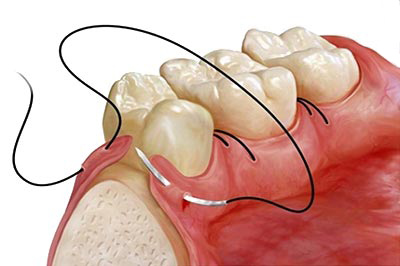Osseous Dental Surgery
 ‘Osseous (pronounced os-ee-uh s) Dental Surgery’ is also known as ‘pocket depth reduction’. It is a surgical procedure intended to restore your gums to a healthier, more natural state. The surgery is a procedure done when you have a pocket around a tooth (or teeth) that has not responded to other treatments, such as Scaling and Root Planing and a maintenance program.
‘Osseous (pronounced os-ee-uh s) Dental Surgery’ is also known as ‘pocket depth reduction’. It is a surgical procedure intended to restore your gums to a healthier, more natural state. The surgery is a procedure done when you have a pocket around a tooth (or teeth) that has not responded to other treatments, such as Scaling and Root Planing and a maintenance program.
When your South Calgary Periodontist recommends Osseous Dental Surgery, it is a procedure used to smooth and reshape the affected bone and create a shallow pocket that makes it more difficult for more aggressive bacteria to survive.
If you have periodontal disease, the supporting tissue and bone are destroyed thus forming a pocket around the affected tooth/teeth. Over time, these pockets become deeper and provide a larger space for bacteria to live in. As bacteria develop around the teeth, they can accumulate and advance under the gum tissue. These deep pockets collect even more bacteria, resulting in further bone and tissue loss. To reduce the need for extractions, Osseous surgery may be recommended.
The goal of Osseous Dental Surgery is to reduce the pocket depth thus eliminating existing bacteria. This is important in preventing damage caused by the progression of periodontal disease. Just eliminating bacteria alone may not be sufficient to prevent the recoccurence of periodontal disease, as deeper pockets are more difficult to keep clean.
The best way to think of Osseous Dental Surgery is like an extra, extra deep cleaning!
The Osseous Procedure:
- The area being worked on will be numbed.
- The gum tissues will be opened up then lifted away from the teeth and underlying bone.
- The periodontist will then clean and smooth the root surface as well as the bone surrounding the root.
- Once the bone surface has been reshaped, the gum tissue is trimmed to match the new underlying structure.
- The gum tissue is then sutured into place.
If periodontitis has eaten away the bone, you may need bone grafting. This is not as scary as it sounds. Basically, bone particle (synthetic, bovine, or human) that looks like sand is mixed together with antibiotics. The mixture is then placed in the area where you have lost bone. Your body reacts like you have broken a bone and starts to heal the area while incorporating your own bone. The result is the regeneration of some of the bone density you may have lost.
Post Surgical Care
Your periodontist may prescribe pain medications to use during the post-surgical healing phase, along with antibiotics and an antibacterial mouthwash. The stitches from your surgery will either fall out on their own or be removed 7 to 21 days after your surgery.
You may experience some root sensitivity or food impaction during the healing phase depending on the severity of your situation. Your South Calgary Periodontist will provide you with home care instructions on how to keep the area clean and what you can or cannot eat.
At South Calgary Periodontal Group, we are always welcoming new patients.
Call us at (403) 278-5446 book your Osseous Dental Surgery consultation appointment today!
